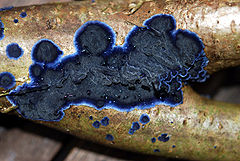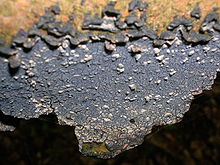- Terana caerulea
-
Terana caerulea 
Scientific classification Kingdom: Fungi Division: Basidiomycota Class: Agaricomycetes Order: Polyporales Family: Phanerochaetaceae Genus: Terana Species: T. caerulana Binomial name Terana caerulea
(Lam.) Kuntze (1891)Synonyms Corticium caeruleum
(Lam.) Fr. (1938)
Pulcherricium caeruleum
(Lam.) Parmasto (1968)Terana caerulea, commonly known as the cobalt crust fungus or velvet blue spread, is a saprobic crust fungus in the family Phanerochaetaceae. Usually found in warm, damp hardwood forests on the undersides of fallen logs and branches of deciduous trees, this unique fungus has been described as "blue velvet on a stick".[1] This species was chosen as fungus of the year for 2009 by the German Mycological Society.[2]
Contents
Description
Cobalt Crust in Ayrshire, Scotland
T. caerulana is resupinate, meaning the fruiting body lies on the surface of the substrate, with the hymenium exposed to the outside. The fruiting body is 2–6 mm thick.[3] It is dark blue with a paler margin, with a velvety or waxy texture when moist, but crusty and brittle when dry. The fruiting body is firmly attached to its growing surface except at the edges. In nature, the fungus surface is typically found pointing downward, which helps facilitate spore dispersal. It usually grows on dead deciduous wood, often ash and hazel.[4] The spore print is white.[3] Spores are ellipsoidal, smooth, thin-walled, hyaline or pale blue, with dimensions of 7–12 × 4–7 µm.[5] The 4-spored basidia are club-shaped, hyaline or blue, with dimensions of 40–60 × 5–7 µm.[5]
Distribution
The cobalt crust has a worldwide distribution in warmer climates, and has been reported from Asia, Africa, New Zealand, North America,[6] the Canary Islands, Europe,[7] Taiwan,[8] Thailand,[9] and Turkey.[10]
Chemistry
The blue pigment of this fungus was shown to be a mixture of polymers structurally related to thelephoric acid.[11]
When activated by external treatments such as high temperature (42 °C (108 °F)), exposure to vapors of toxic solvents, or contact with a water-toluene mixture, T. caerulea produces an antibiotic named cortalcerone (2-hydroxy-6H-3-pyrone-2-carboxaldehyde hydrate), that inhibits the growth of Streptococcus pyogenes.[12] The metabolic biosynthesis of this compound starting from the initial precursor glucose has also been studied.[13][14][15]
Compounds with so-called "benzobisbenzofuranoid" skeletons have been isolated and identified from T. caerulea, namely, corticins A, B, and C.[16]
References
- ^ "Phlebia coccineofulva, Hyphoderma puberum, and Pulcherricium caeruleum — some patriotic corticioid (crust) fungi Tom Volk's Fungus of the Month for July 2000". http://botit.botany.wisc.edu/toms_fungi/july2000.html. Retrieved 2009-02-09.
- ^ "Pilz des Jahres 2009: Blauer Rindenpilz (Pulcherricium caeruleum): DGfM". http://dgfm-ev.de/index.php?id=pdj_2009. Retrieved 2009-02-09.
- ^ a b Miller HR, Miller OK. (2006). North American Mushrooms: a Field Guide to Edible and Inedible Fungi. Guilford, Conn: Falcon Guide. p. 433. ISBN 0-7627-3109-5. Google Books
- ^ "sita.siv-ars.it". http://sita.siv-ars.it/sita/pdf/h/121.pdf. Retrieved 2009-02-09.[dead link]
- ^ a b Ellis, J. B.; Ellis, Martin B. (1990). Fungi Without Gills (Hymenomycetes and Gasteromycetes): an Identification Handbook. London: Chapman and Hall. p. 165. ISBN 0-412-36970-2.
- ^ "wood-rotting fungi". http://lsb380.plbio.lsu.edu/wood-rotting%20fungi.html. Retrieved 2009-02-09.
- ^ Krieglsteiner GJ. (1983). "The blue corticium Pulcherricium caeruleum and its occurrence in Europe". Zeitschrift für Mykologie 49(1): 61–72.
- ^ Wu S-H, Chen Z-C. (1989). "Pulcherricium caeruleum new record (Fr. Parm. Corticiaceae, Basidiomycetes). A new record from Taiwan". Taiwania 34(1): 1–4.
- ^ Hjorstam K, Ryvarden L. (2008). "Aphylophorales from Northern Thailand". Nordic Journal of Botany 2(3): 273–281.
- ^ Sesli E. (2008). "Checklist of the Turkish ascomycota and basidiomycota collected from the Black Sea region". Mycotaxon 99: 71–74. PDF
- ^ Neveu A, Baute R, Bourgeois G, Deffieux G. (1974)."Recherches sur le pigment bleu du champignon Corticium caeruleum (Schrad. ex Fr.) Fr. (Aphyllophorales)". Bulletin de la Societe de pharmacie de Bordeaux 113(3): 77–85.
- ^ Baute R, Baute M-A, Deffieux G, Filleau M-J. (1976). "Cortalcerone, a new antibiotic induced by external agents in Corticium caeruleum". Phytochemistry 15(11): 1753–1755.
- ^ Baute R, Baute M-A, Deffieux G, Filleau M-J. (1977). "Conversion of glucose to cortalcerone via glucosone by Corticium caeruleum". Phytochemistry 16(12): 1895–1897.
- ^ Baute M-A, Baute R. (1984). Occurrence among macrofungi of the bioconversion of glucosone to cortalcerone. Phytochemistry 23(2): 271–274.
- ^ Baute R, Baute M-A, Deffieux G. (1987). Proposed pathway to the pyrones cortalcerone and microthecin in fungi". Phytochemistry 26(5): 1395–1397.
- ^ Briggs LH, Cambie RC, Dean IC, Hodges R, Ingram WB, Rutledge PS. (1976). "Chemistry of fungi. XI. Corticins A, B, and C, benzobisbenzofurans from Corticium caeruleum". Australian Journal of Chemistry 29: 179–190. Abstract
External links
Categories:
Wikimedia Foundation. 2010.


